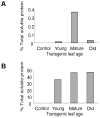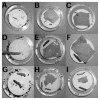Overexpression of the Bt cry2Aa2 operon in chloroplasts leads to formation of insecticidal crystals
- PMID: 11135556
- PMCID: PMC4560096
- DOI: 10.1038/83559
Overexpression of the Bt cry2Aa2 operon in chloroplasts leads to formation of insecticidal crystals
Abstract
In nuclear transgenic plants, expression of multiple genes requires introduction of individual genes and time-consuming subsequent backcrosses to reconstitute multi-subunit proteins or pathways, a problem that is compounded by variable expression levels. In order to accomplish expression of multiple genes in a single transformation event, we have introduced several genes into the chromoplast genome. We confirmed stable integration of the cry2Aa2 operon by PCR and Southern blot analyses in T(0) and T(1) transgenic plants. Foreign protein accumulated at 45.3% of the total soluble protein in mature leaves and remained stable even in old bleached leaves (46.1%), thereby increasing the efficacy and safety of transgenic plants throughout the growing season. This represents the highest level of foreign gene expression reported in transgenic plants to date. Insects that are normally difficult to control (10-day old cotton bollworm, beet armyworm) were killed 100% after consuming transgenic leaves. Electron micrographs showed the presence of the insecticidal protein folded into cuboidal crystals. Formation of crystals of foreign proteins (due to hyperexpression and folding by the putative chaperonin, ORF 2) provides a simple method of purification by centrifugation and enhances stability by protection from cellular proteases. Demonstration of expression of an operon in transgenic plants paves the way to engineering new pathways in plants in a single transformation event.
Figures






References
-
- Bogorad L. Engineering chloroplasts: an alternative site for foreign genes, proteins, reactions, and products. Trends Biotechnol. 2000;18:257–263. - PubMed
-
- Ma J, et al. Generation and assembly of secretory antibodies in plants. Science. 1995;268:716–719. - PubMed
-
- Ye X, et al. Engineering the provitamin A (β-carotene) biosynthetic pathway into (carotenoid-free) rice endosperm. Science. 2000;287:303–305. - PubMed
-
- Daniell H. New tools for chloroplast genetic engineering. Nat Biotechnol. 1999;17:855–856. - PubMed
Publication types
MeSH terms
Substances
Grants and funding
LinkOut - more resources
Full Text Sources
Other Literature Sources

